Oct. 09, 2021
Mayo Clinic Physical Medicine and Rehabilitation specialists Jeffrey S. Brault, D.O., and Jane Konidis, M.D., discuss two minimally invasive treatments for carpal tunnel syndrome and tendinopathy.
Thread ultrasound-guided carpal tunnel release
Carpal tunnel syndrome is common, and an estimated 71% of patients receive surgical intervention as their primary treatment. The estimated cost of medical care for carpal tunnel syndrome in the United States is $2 billion a year, with a median lost work time of just under 30 days.
The goal of carpal tunnel release surgeries is to decompress the median nerve by dividing the transverse carpal ligament (TCL). The two most common surgical interventions are open carpal tunnel release (OCTR) and endoscopic carpal tunnel release (ECTR). Endoscopic approaches are usually associated with less postoperative pain and a faster return to work, but also with increased risk of nerve injury and incomplete release.
Mayo Clinic is one of the few hand centers that offer ultrasound-guided intervention for carpal tunnel release. A newer, incisionless treatment release — known as thread ultrasound-guided carpal tunnel release (TCTR) — uses an abrasive thread looped percutaneously to dissect the TCL and is performed using local anesthesia.
In an article published in Techniques in Hand & Upper Extremity Surgery in 2021, Mayo Clinic authors provide a step-by-step overview of TCTR and review published clinical outcomes. Co-authors include Dr. Brault and orthopedic surgeon Alexander Y. Shin, M.D., who perform TCTR at Mayo Clinic's campus in Rochester, Minnesota.
Technique
Step 1
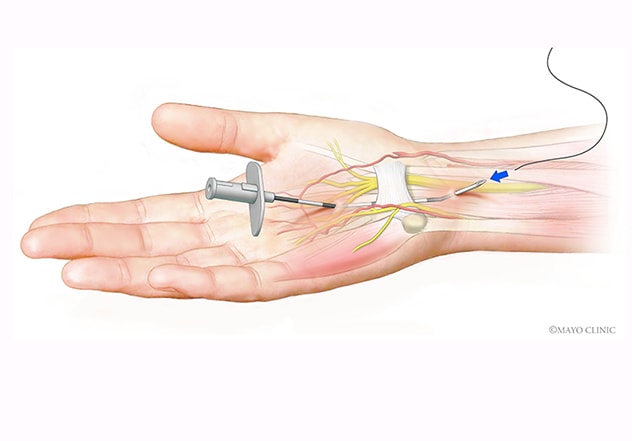
Step 1
Under ultrasound guidance, a needle is passed under the carpal tunnel and above the median nerve, and a cutting thread is passed through the needle's tip.
Step 2
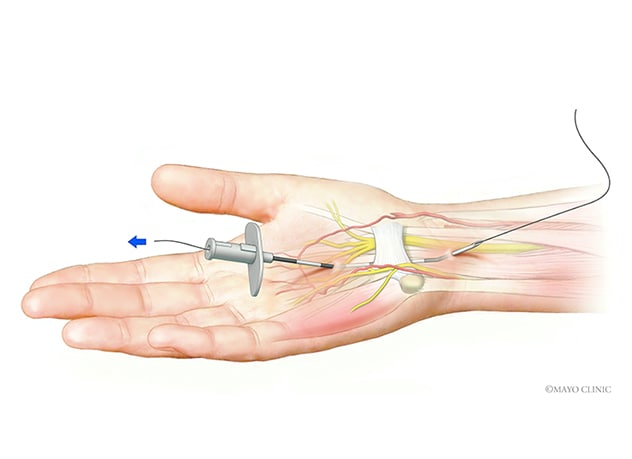
Step 2
The needle is passed above the carpal tunnel, using the same entry and exit points as the first pass.
Step 3
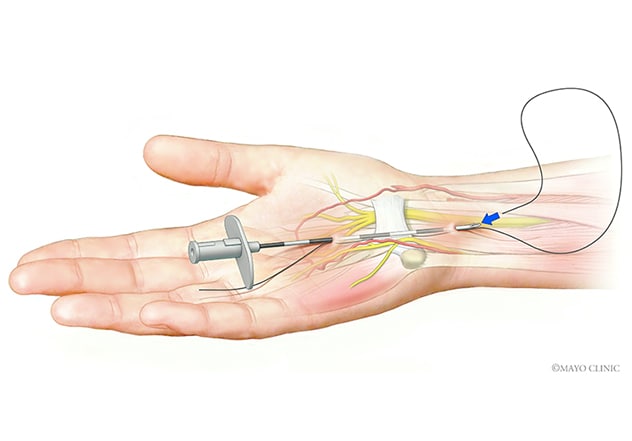
Step 3
Cutting thread is again passed through the needle, creating a loop.
Step 4
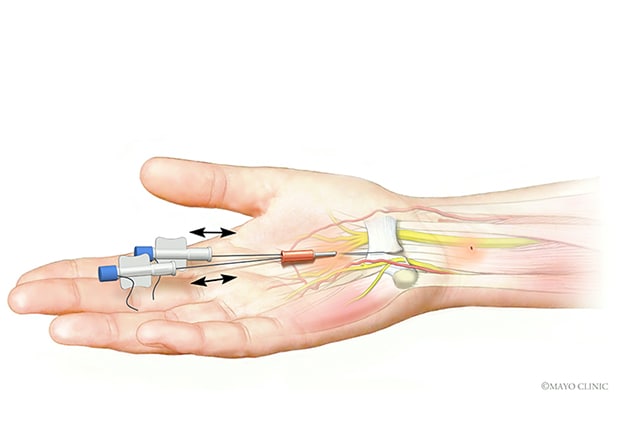
Step 4
The ends of the cutting threads are gently tugged, to cut the ligament.
Step 5
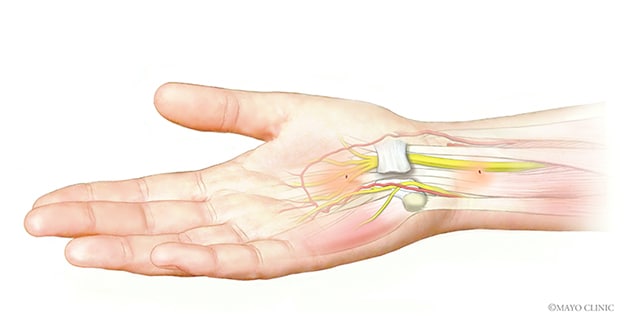
Step 5
The carpal tunnel ligament has been severed with an incisionless procedure.
TCTR is designed to minimize soft tissue dissection and injury, decrease pillar pain, and accelerate recovery. In their article and accompanying video, Drs. Brault and Shin outline the five-step incisionless procedure.
Outcomes and experience to date
Since the procedure's introduction, Drs. Brault and Shin note that minor revisions in its protocol have helped reduce incomplete transection rates. Patients typically recover in about two weeks instead of the 4 to 6 weeks needed after open surgery.
Although published clinical outcome data associated with TCTR are limited at this time, the published data discussed by the co-authors suggest that patients treated with TCTR had symptom severity scores, function scores and satisfaction rates exceeding those associated with OCTR and ECTR in comparable studies, with no adverse events.
"Ultrasound-assisted, minimally invasive procedures such as the thread carpal tunnel release have the potential to revolutionize how we treat some common conditions," explains Dr. Brault. "Thread carpal tunnel release is an eloquent and straightforward technique that offers patients quicker pain relief and recovery than conventional open carpal tunnel releases."
Percutaneous ultrasound-guided hydrotenotomy
This approach to treating chronic tendinopathy is an example of efforts to develop effective, minimally invasive interventions for tendon disorders, which are common problems that are difficult to treat.
Percutaneous tenotomy with a high-pressure saline jet (percutaneous pressured hydrotenotomy) provides a new tool for the debridement and aspiration of degenerative tissue associated with chronic tendinopathy. Performed under ultrasound guidance, the procedure involves the use of a nonthermal adjustable high-pressure stream of saline that acts as a selective debridement tool. The tool creates an in-line suction effect that allows for simultaneous debridement and aspiration of diseased tissue while preserving healthy surrounding tissue.
Proponents of this tool are hopeful that it will provide an alternative to mechanical, ultrasonic and radiofrequency resection and debridement procedures while sparing healthy tendon tissue. Percutaneous pressured hydrotenotomy under ultrasound guidance is performed in an outpatient setting without the need for general anesthesia. Patients are evaluated for candidacy prior to the procedure. After the procedure, there is a period of rehabilitation over the course of several weeks, depending on the location of the procedure. Patients can expect to see improvements in their symptoms within the first six weeks and continued improvements in the following months.
Dr. Konidis, a physiatrist at Mayo Clinic's campus in Rochester, Minnesota, has more than two years of experience using this approach to treat patients with chronic and calcific tendinopathy. Overall, Dr. Konidis is encouraged by her experiences using this technique.
"This approach offers greater ease of use than some of the other minimally invasive tenotomy equipment available," explains Dr. Konidis. "Aspiration of both diseased tendon and calcifications, visualized live under ultrasound, is more effective. The length of the tool allows the operator to reach more areas, and the device doesn't clog easily. Additionally, the saline jet is safer to use as it does not inadvertently debride normal tendon."
Dr. Konidis notes that this approach may be well suited for treatment of lateral and medial epicondylitis (tennis elbow and golfer's elbow), calcific tendinopathy, plantar fasciitis, Achilles tendinopathy, patellar tendinopathy, rotator cuff tendinopathy, and gluteal tendinopathy.
Based on their clinical experience and available safety and efficacy data, Dr. Konidis and others note that this technology is promising and has been safely and effectively used in thousands of patients across the United States. At the 2019 American Medical Society for Sports Medicine meeting, researchers presented a multicenter prospective clinical study with six months of follow-up that included 29 patients diagnosed with lateral and medial epicondylitis. Since then, the researchers have gathered one-year follow-up data and plan to publish their findings. In a poster presentation at the 2021 meeting of the American College of Foot and Ankle Surgeons, researchers described the use of this treatment in 41 patients with plantar fasciitis. Furthermore, a group of physicians at a major academic center with a database of over 1,000 patients who have undergone hydrotenotomy has not reported a single case of rupture associated with this treatment.
For more information
Schrier VJ, et al. An incision-less ultrasound-guided carpal tunnel release technique. Techniques in Hand & Upper Extremity Surgery. 2021;25:14.
Thread ultrasound-guided carpal tunnel release. Mayo Clinic.